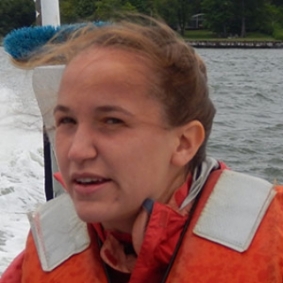Eight students will be presenting the summer work at the Ocean Sciences Meeting in March 2022!
Anna McClain, St. Mary's College of Maryland
Class Year:
2015Mentor:
Jeffrey Cornwell, Ph.D.Project Title:
Carbonate Chemistry in the Chesapeake Bay: The Effect of the Eastern Oyster, Crassostrea virginica
Abstract:
There are ongoing oyster reef restoration projects in the Chesapeake Bay and these new ecosystems have yet to be fully explored. The carbonate system in an oyster reef is complex with contributions from respiration, calcium carbonate precipitation and dissolution, and other organic and inorganic processes. This experiment aimed to determine the overall effect of all of those processes by looking at the carbonate chemistry balance in a restored oyster reef. D filled with varying amounts of oyster reef material were left in the field for about a month before they were collected and an ex-situ incubation was performed over several hours. The trays with high densities of oysters had significantly higher rates of dissolved inorganic carbon increase and total alkalinity increase compared to trays with low densities or no oysters. High density trays had DIC fluxes of 29776.8±7593.2 µmol DIC m-2 hr-1 and TA fluxes of 20119.1±11107.6 µmol TA m-2 hr-1. High densities of oysters resulted in respiration controlling the carbonate system and forcing oyster shell dissolution.
Location:
Horn Point LaboratoryPresentations:
McClain, A.*, J. Cornwell, M. Owens, and L. Kellogg. 2015. Carbonate chemistry in experiment incubations of restored Chesapeake Bay oyster communities . Coastal Estuarine Research Federation Biennial Meeting, Portland, Oregon .




